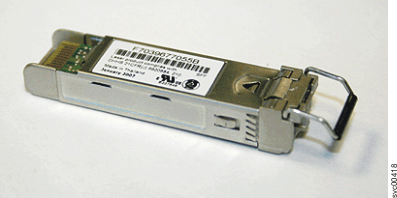When a failure occurs on a single link, the SFP transceiver might
need to be replaced.
Even though many of these components are hot-swappable, they are
intended to be used only when your system is not active (no I/O operations). If your system
is powered on and processing I/O operations, go to the management GUI and follow the fix procedures. Initiating the replacement actions
without the assistance of the fix procedures can result in loss of
data or loss of access to data.
Be careful when
you are replacing the hardware components that are located in the
back of the system that you do not inadvertently disturb or remove
any cables that you are not instructed to remove.
CAUTION:
Some laser products contain an embedded Class 3A or Class 3B laser
diode. Note the following information: laser radiation when open.
Do not stare into the beam, do not view directly with optical instruments,
and avoid direct exposure to the beam.
Perform the following steps to remove and then replace an SFP transceiver:
- Carefully determine the failing physical port connection.
Important: The Fibre Channel links in the enclosures
are supported with both longwave SFP transceivers and shortwave SFP transceivers. A longwave SFP transceiver has
some blue components that are visible even when the SFP transceiver is
plugged in. You must replace an SFP transceiver with
the same type of SFP transceiver that
you are replacing. If the SFP transceiver to
replace is a longwave SFP transceiver,
for example, you must replace with another longwave SFP transceiver.
Removing the wrong SFP transceiver might
result in loss of data access.
- Remove the optical cable by pressing the release tab and
pulling the cable out. Be careful to exert pressure only on the connector
and do not pull on the optical cables.
- Remove the SFP transceiver.
There are a number of different handling or locking mechanisms that
are used on the SFP transceivers. Some SFP transceivers might have a plastic tag. If so, pull the tag to remove the SFP transceiver.
Important: Always check that the SFP transceiver that
you replace matches the SFP transceiver that
you remove.
- Push the new SFP transceiver into
the aperture and ensure that it is securely pushed home. The SFP transceiver usually
locks into place without having to swing the release handle until
it locks flush with the SFP transceiver. Figure 1 illustrates
an SFP transceiver and its release handle.
Figure 1. SFP transceiver

- Reconnect the optical cable.
- Confirm that the error is now fixed. Either mark the error
as fixed or restart the node depending on the failure indication that
you originally noted.
